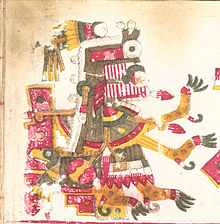Tzitzimitl

Tzitzimitl (plural tzitzimime , Nahuatl : elderly grandmother) was called a female deity in Aztec mythology who was assigned to the stars. Tzitzimime were seen as monsters descending from above .
Appearance
Tzitzimime were mostly depicted as female skeletons, dressed with skirts, skulls and bones. Although they were clearly female, some pictures show them with a phallus in the shape of a snake. Sometimes they wear necklaces made from human hearts or earrings in the shape of a human hand. Elsewhere they are depicted as spiders.
Mythological meanings
In Aztec mythology, the role of the tzitzimime was contradicting itself. Because of the hostile aspects that were assigned to them, they were often referred to as demons or even devils in Christian-influenced descriptions after the Conquista . However, that shortens the meaning they had in the Aztec pantheon . In fact, the Tzitzimime were goddesses who had to do with reproduction and fertility and were therefore invoked primarily by midwives and women giving birth. Thematically they were therefore associated with other female deities, for example with Cihuateteo , Coatlicue and Citlalicue , but also with Itzpapalotl , a powerful warrior who was sometimes seen as the leader of the Tzitzimime. Apart from their reproductive functions, the tzitzimime were considered dangerous. During solar eclipses one believed to see Tzitzimime in the stars, which one then saw around the darkened sun, who attacked the sun in order to prevent it from shining again. It is also believed that the Tzitzimime used solar eclipses to descend to earth and devour people. The Tzitzimime was also feared during Nemontemi, a five-day period in the Aztec calendar that was viewed as a period of calamity. It was generally believed that they wanted to destroy the earth and therefore fought the sun at every sunrise and every sunset.
Tzitzimitl and the pulque
The Histoyre du Mechique contains a mythical interpretation of the origin of the pulque : namely, after the creation of mankind, the gods decided to give people something that made them dance. Quetzalcoatl woke the lovely goddess Mayahuel and persuaded her to come to earth with him. There they both united to form a forked tree. Mayahuel's malicious grandmother, a Tzitzimitl, mobilized the rest of the Tzitzimime to find the renegade Mayahuel. These rushed down on the tree, which broke apart under their onslaught. Mayahuel's grandmother discovered it in one of the branches, tore it into a thousand pieces and fed it to the rest of the tzitzimime. After the dark star goddesses were back in the sky, Quetzalcoatl buried Mayahuel's bones in the earth. Wherever he buried a piece, an agave later grew , the raw material from which pulque (Nahuatl: ixtac octli ) is obtained.
literature
- Karl Taube : Aztec and Maya myths , Phillip Reclam jun. Stuttgart (1994), ISBN 3-15-010427-0 .
- Bernardino de Sahagún : Transcription of the Náhuatl text a. engl. Translation by Thelma D. Sullivan, ed. by HB Nicholson, Norman, University of Oklahoma Press, (1997).
- Cecelia F. Klein: The Devil and the Skirt: An iconographic inquiry into the prehispanic nature of the Tzitzimime , Estudios de Cultura Náhuatl: pp. 17-62. Universidad Nacional Autónoma de Mèxico (2000).
- George Clapp Vaillant : Die Azteken , Verlag M. Dumont Schaumberg Cologne (1957).
